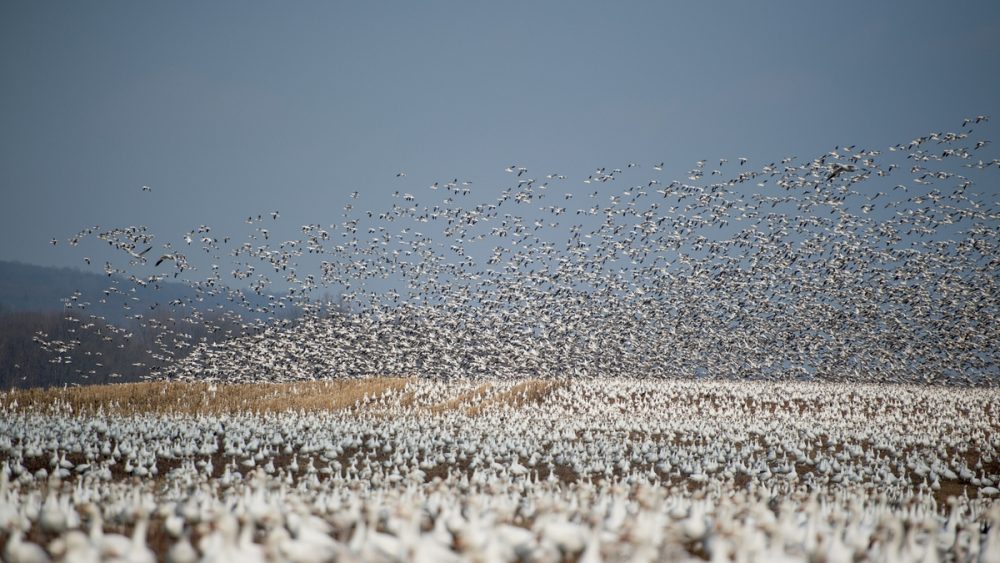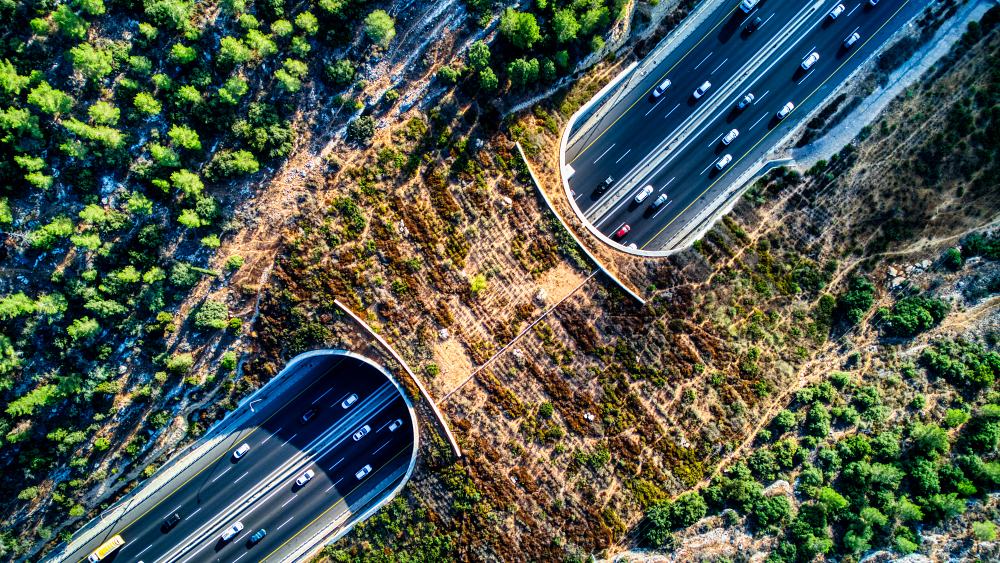Photo Credit: Wildlife Crossing, A1, Israel: Hagai Agmon-Snir, CC BY-SA 4.0 via Wikimedia Commons
Wildlife is increasingly threatened by habitat fragmentation as agricultural expansion and urban development carve into natural landscapes. In the midst of this growing challenge, wildlife corridors have emerged as a vital solution, balancing the demands of human expansion with the urgent need to preserve and reconnect animal habitats. These crucial passageways ensure that wildlife can still roam, forage, and prosper even as their traditional territories encounter the encroaching presence of human activity.
What are Wildlife Corridors?
Wildlife corridors are designated pathways that enable animals to move between separate, often isolated habitats, which can be disrupted by human activities like urban development, highways, or agricultural expansion.
Corridors come in various forms, each tailored to the landscape and the needs of local wildlife. Natural corridors are pre-existing routes like riverbanks or mountain ridges that animals use to travel between habitats. Man-made corridors are constructed specifically for conservation purposes, such as wildlife bridges over highways or tunnels under roads, designed to reduce wildlife-vehicle collisions and enable safe passage. Other innovative solutions include rope bridges for arboreal species or fish ladders for aquatic fauna. Each type is crucial in its way, addressing specific challenges posed by human infrastructure and urban development.
The scope of wildlife corridors varies greatly in scale and complexity. On a smaller scale, they can be as simple as a crossing over a freeway, allowing animals like deer, coyotes, or even mountain lions to safely navigate urban landscapes. On a much larger scale, they can encompass vast regions, facilitating seasonal migrations over hundreds of miles, such as the corridor that allows monarch butterflies to travel between Mexico and the United States, or the pathways used by wildebeest in the Serengeti.
The overarching role of wildlife corridors is to facilitate the movement of species, a fundamental aspect of their survival and adaptation. In today’s world, where natural habitats are often separated by human-made barriers, these corridors provide a crucial means for species to access different areas for feeding, breeding, and seasonal migrations. They are especially important for wide-ranging species, like large carnivores and migratory birds, which require extensive territories. Beyond individual species movement, these corridors are instrumental in connecting habitat patches, creating a more cohesive and functional ecosystem, and ensuring long-term sustainability of wildlife populations.
Composition and Scope of Wildlife Corridors
Public and Private Lands Integration
Wildlife corridors often encompass a blend of public and private lands, creating a patchwork of interconnected habitats. Public lands, like national parks and forests, often serve as anchor points or core areas for these corridors. However, private lands are equally vital, especially in regions where significant tracts of natural habitat are under private ownership. In many cases, private landowners voluntarily participate in conservation efforts, allowing their land to be part of these crucial ecological pathways. This integration is essential for forming an extensive and effective network of corridors that can support diverse wildlife species.
Collaboration Across Sectors
The establishment and maintenance of wildlife corridors require a collaborative effort that spans various sectors. Governments play a pivotal role through policy-making, funding, and the establishment of protected areas. Conservationists and environmental organizations contribute with research, planning, and on-ground implementation. Perhaps most critically, the involvement and support of local communities and landowners are essential for the success of these corridors. Their willingness to adapt land use practices and participate in conservation initiatives is often the linchpin in creating effective and sustainable wildlife corridors.
Challenges in Diverse Landscapes
Incorporating wildlife corridors into different landscapes presents a unique set of challenges. In vast natural reserves, the primary concern may be maintaining the integrity and connectivity of habitats while balancing tourism and conservation. In contrast, urban and suburban settings require innovative solutions to navigate busy roads, industrial areas, and residential zones. Each landscape demands a tailored approach, taking into account local ecological conditions, species requirements, and human-wildlife interactions. The goal is to create corridors that are not only effective for wildlife movement but also sustainable and harmonious within their respective environments.
The Role and Benefits of Wildlife Corridors

Wild geese during migration season at Newmanstown, Pennsylvania, United States. Wikimedia Commons.
Wildlife corridors are critical elements of ecological infrastructure, bridging fragmented habitats and fostering a robust natural environment. Their absence would result in insurmountable barriers for wildlife, leading to detrimental effects on biodiversity and ecosystem health.
Enhancing Genetic Diversity
Wildlife corridors are crucial in maintaining genetic diversity among animal populations. When populations become isolated due to fragmented habitats, they face the risk of inbreeding and genetic drift, which can lead to decreased resilience and increased vulnerability to diseases. Corridors facilitate the movement of individuals between populations, promoting gene flow and genetic diversity. This genetic exchange is vital for the health and adaptability of species, helping to ensure robust, resilient populations capable of withstanding environmental changes and disease pressures.
Facilitating Essential Resources Access and Seasonal Migrations
Wildlife corridors play a pivotal role in ensuring animals have access to essential resources such as food, water, and suitable breeding sites. Many species depend on seasonal migrations to find these resources, and corridors provide safe passage for these journeys. For instance, corridors enable herbivores to follow seasonal vegetation changes or salmon to travel to their spawning grounds. Without these corridors, animals might be forced to traverse dangerous landscapes, leading to increased mortality rates and decreased breeding success, severely impacting population health and stability.
Adapting to Environmental and Climatic Changes
As climate change alters habitats and resource availability, wildlife corridors become increasingly important for species adaptation. They provide routes for species to move to more suitable habitats as their traditional territories become less hospitable due to temperature shifts, changes in vegetation, or water availability. These corridors are particularly crucial for species with limited range tolerance, as they offer alternate habitats and resources that might not be available in their current range. The absence of such corridors can lead to population declines and extinctions, as species are unable to adapt to rapidly changing environmental conditions.
Supporting Habitat Variety
These pathways offer diverse habitats crucial for the survival of many species. Without the habitat variety provided by corridors, species requiring different environmental conditions might fail to thrive, reducing biodiversity.
Creating Urban Greenbelts
In urban settings, corridors double as green spaces, enhancing recreational, aesthetic, and property values. The absence of these greenbelts would diminish the quality of urban life and reduce the opportunities for city dwellers to connect with nature.
Reducing Energy Costs
Particularly in forested or plantation areas, corridors serve as windbreaks, reducing heating and cooling costs. Without them, buildings may incur higher energy expenditures due to increased exposure to the elements.
The presence of wildlife corridors is a testament to the foresight of conservation, ensuring the continuity and resilience of natural processes in the face of human development. Their benefits stretch far beyond ecological roles, touching upon social, economic, and environmental spheres. The imperative to protect and establish these corridors has never been more pressing, as they offer a beacon of hope for wildlife coexistence and biodiversity conservation.
Challenges Posed by Human Activities and Climate Change
Habitat Fragmentation from Urbanization, Agriculture, and Infrastructure
Human activities, notably urbanization, agriculture, and infrastructure development, have significantly fragmented natural habitats. Urban sprawl leads to the division of once-cohesive ecosystems into smaller, isolated patches, impeding the movement of wildlife and disrupting their natural behaviors. Agriculture expands over large areas, replacing natural habitats with monocultures and farmlands, while roads and other infrastructure create physical barriers. This fragmentation not only limits the range and movement of wildlife but also diminishes the ecological integrity of habitats, making it difficult for species to find food, mates, and shelter.
Climate Change and its Impact on Migratory Patterns
Climate change is altering migratory patterns and the availability of essential resources for wildlife. As temperatures rise and weather patterns shift, habitats and ecosystems undergo significant changes. This can lead to the displacement of food sources, changes in breeding grounds, and alterations in the timing of seasonal migrations. Species that depend on specific environmental cues for migration may find their traditional routes disrupted, leading to challenges in survival and reproduction.
Increased Human-Wildlife Conflicts and Physical Barriers
The encroachment of human activities into natural habitats has led to increased conflicts between wildlife and humans. Roads, fences, and urban developments act as physical barriers to animal movement, often leading to dangerous wildlife crossings that result in accidents and fatalities for both animals and humans. These barriers can force animals to take longer, more hazardous routes, increasing their vulnerability to predators and environmental hazards. Additionally, as animals venture into human-populated areas in search of food or passage, the potential for conflict escalates, often resulting in harm to both wildlife and human communities.
Protecting and Establishing Wildlife Corridors
The Necessity of Wildlife Corridors in Contemporary Conservation
In the modern era, where natural habitats are increasingly fragmented by human activities, the creation and protection of wildlife corridors have become imperative. These corridors are essential for maintaining biodiversity, supporting ecosystems, and ensuring the survival of numerous species. They enable animals to navigate through landscapes altered by human development, thereby reducing the risk of isolation and local extinctions. As such, wildlife corridors are not just beneficial for wildlife; they are crucial components in preserving the ecological balance and health of our planet.
Implementing Safe Passage Strategies
To facilitate safe animal movement, a range of strategies is employed in the construction and maintenance of wildlife corridors. Overpasses and underpasses, specifically designed for wildlife crossings over or under roads and highways, are effective solutions in reducing wildlife-vehicle collisions and enabling uninterrupted animal movement. Additionally, preserving and maintaining undisturbed habitats along migratory routes is crucial. This includes protecting natural landscapes like forests, wetlands, and river corridors, which serve as natural pathways for wildlife.
Regulatory Measures for Conflict Mitigation and Route Protection
Regulatory measures are vital in mitigating human-wildlife conflicts and safeguarding critical migratory routes. This may involve enforcing wildlife protection laws, regulating land use in key areas, and implementing policies that promote wildlife-friendly practices in agriculture and urban planning. Such regulations help in minimizing the negative impacts of human activities on wildlife corridors and ensure that these essential pathways remain effective and safe for animal movement. Furthermore, policies that encourage collaboration between various stakeholders, including governments, conservation groups, and local communities, are essential for the successful establishment and maintenance of wildlife corridors.
Famous Wildlife Corridors
Among the numerous wildlife corridors established worldwide, several have gained prominence due to their scale, the critical habitats they connect, or the diversity of wildlife they support. These corridors have become famous not just for their sheer size or the innovative approaches employed in their creation, but also for their significant role in facilitating the movement of a wide range of species and preserving crucial ecosystems. From vast transcontinental pathways to critical links within densely populated regions, these corridors stand as exemplary models in wildlife conservation, demonstrating effective solutions to the challenges of habitat fragmentation and species preservation. Let’s examine some of these well-known wildlife corridors and understand what makes them so vital to global biodiversity efforts.
The Mesoamerican Biological Corridor
The Mesoamerican Biological Corridor is an expansive network that stretches from Panama to Mexico, linking the ecosystems of Central America. This corridor is crucial for the migration and survival of numerous species, including jaguars, tapirs, and countless bird species. It enables the movement of wildlife across different countries and habitats, playing a significant role in preserving the incredible biodiversity of the region. The corridor also facilitates genetic exchange and species adaptation across its vast expanse, contributing to the resilience of Central American ecosystems.
Yellowstone to Yukon Conservation Initiative
The Yellowstone to Yukon (Y2Y) Conservation Initiative is an ambitious project that aims to connect habitats from Yellowstone National Park in the United States to the Yukon in Canada. This corridor addresses the needs of wide-ranging species like grizzly bears, wolves, and caribou, ensuring they have access to large territories required for their survival. By linking a network of protected areas, the Y2Y initiative not only facilitates wildlife movement but also helps in maintaining ecological processes and mitigating the impacts of climate change across a vast, transboundary landscape.
Santa Monica Mountains Wildlife Crossing
The planned wildlife crossing over the U.S. Route 101 in the Santa Monica Mountains of California is a prime example of urban wildlife corridor implementation. Designed to reconnect areas of the mountain range that have been divided by the highway, this crossing will be crucial for local species, particularly the mountain lion, allowing safe passage and reducing the risks of road accidents. This crossing stands as a model for integrating wildlife conservation into urban planning, showcasing how infrastructure can be adapted to support biodiversity in metropolitan areas.
Other Notable Corridors
Other significant wildlife corridors include the Terai Arc Landscape, which spans India and Nepal, providing a continuous habitat for tigers, elephants, and rhinoceroses. In Europe, the European Green Belt follows the path of the former Iron Curtain, serving as a corridor for species like lynxes and wolves and demonstrating how former political boundaries can transform into ecological bridges. These corridors, each unique in their geographical and ecological contexts, exemplify the diverse approaches to creating lifelines for wildlife in different parts of the world.
Threats to Wildlife Corridors: The Impact of the U.S.-Mexico Border Wall
Wildlife corridors are crucial for the free movement of animals across ecosystems, supporting natural behaviors like migration, feeding, and breeding. However, these lifelines face significant threats, particularly from man-made structures. One of the most notable of these is the US-Mexico border wall, a sprawling barrier with profound implications for wildlife.
The U.S.-Mexico Border Wall as a Barrier
Stretching over a considerable distance, the U.S.-Mexico border wall stands as a formidable physical barrier. It cuts through various landscapes, some of which are key habitats for wildlife. This wall not only demarcates political boundaries but also disrupts the natural territory of numerous species.
Impact on Seasonal Migration and Animal Lives
The border wall severely hampers the migratory routes of many species. Animals like jaguars, which roam across the U.S.-Mexico border, find their paths blocked, leading to disrupted mating and feeding patterns. Even birds, whether ground-dwelling, low-flying, or migratory, are impeded by the wall, potentially leading to a decline in their populations.
Consequences for Species and Biodiversity
The restriction of movement caused by the wall can lead to isolated wildlife populations, increasing the risk of inbreeding and loss of genetic diversity. This isolation poses a significant threat to the health and survival of species, potentially leading to local extinctions. The overall impact is a decrease in biodiversity and ecosystem resilience in the border region.
Encroachment on Protected Natural Areas
Parts of the border wall have been constructed through areas designated for wildlife protection and natural reserves. This encroachment not only violates environmental regulations but also undermines ongoing conservation efforts. Protected species in these areas, many of which are already vulnerable or endangered, face additional threats to their survival due to habitat fragmentation.
Advocacy and Efforts for Protection
Various organizations and groups are actively working to combat the negative impacts of the border wall on wildlife corridors. Conservationists, environmental groups, and some governmental agencies are advocating for wildlife-friendly designs in barrier construction. Legal challenges have been raised against the wall’s encroachment on protected areas, and there is a growing movement calling for policies that prioritize ecological considerations in border security measures. These efforts are crucial in ensuring the preservation of biodiversity and the integrity of wildlife corridors.
Here are some notable organizations working on the border wall issue:
- The Center for Biological Diversity has been at the forefront, advocating for wildlife-friendly designs and legally challenging the wall’s construction in critical habitats.
- The Sierra Club, through its Borderlands campaign, focuses on protecting the unique ecosystems along the border.
- The Wildlife Corridor Conservation Authority (WCCA) actively promotes the creation of new corridors and the protection of existing ones.
- Local groups like Cuenca Los Ojos and the Sky Island Alliance are dedicated to preserving the cross-border habitats that are crucial for numerous species.
These organizations, along with governmental agencies and conservationists, play a vital role in advocating for policies that prioritize ecological integrity and wildlife movement in border security measures.
The U.S.-Mexico border wall presents a stark example of how man-made structures can pose significant threats to wildlife corridors. The disruption of natural migratory paths and the fragmentation of habitats have far-reaching consequences for animal populations and overall biodiversity. It is imperative that wildlife movement is factored into policy and infrastructure decisions. Raising awareness and advocating for the protection of these vital ecological passageways is essential for the health of our planet’s ecosystems.
Conclusion
The significance of wildlife corridors in the realm of ecological conservation cannot be overstated. These corridors are more than just pathways; they are vital lifelines that support animal migration, safeguard biodiversity, and play a crucial role in the survival of endangered species. By bridging fragmented habitats, they enable species to maintain natural behaviors, access essential resources, and ensure genetic diversity, which is fundamental for healthy ecosystems.
There is a pressing need for concerted efforts from the conservation community, governments, and the public to advocate for and invest in the establishment and maintenance of these corridors. It involves not only protecting existing natural passageways but also innovatively integrating man-made solutions in urban and agricultural landscapes. The commitment to wildlife corridors must be seen as a commitment to the future of our planet’s biodiversity.
In conclusion, wildlife corridors symbolize a harmonious coexistence between humans, wildlife, and nature. They represent a shared understanding that preserving and connecting natural habitats is critical for the well-being of our planet. As we move forward, it is imperative to recognize and support these corridors as essential components in the global effort to conserve nature’s diversity, ensuring a rich and vibrant world for future generations.
- 30 Environmental Activities to Feed Your Mind, Body & Soul - December 19, 2023
- Exploring the Wonders of Dark Sky Parks: A Stargazer’s Paradise - December 19, 2023
- Biodiversity Loss – A Crisis in the Making - December 12, 2023











